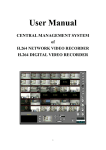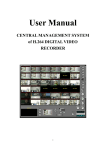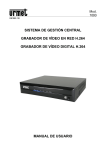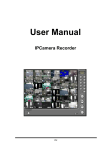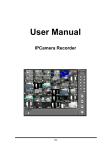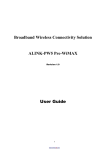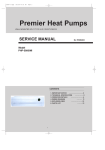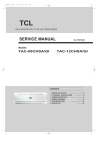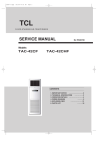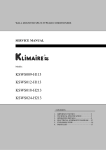Download User Manual - ademco.com.au
Transcript
User Manual Capture Central Management System Software for CDR Series V 1.1 1 TABLE of CONTENTS I. II. SPECIFICATION................................................................................................3 HARDWARE REQUIREMENTS......................................................................6 A. MINIMUM REQUIREMENTS..................................................................6 B. SUGGESTED REQUIREMENTS .............................................................6 II. CENTRAL MANAGEMENT SYSTEM SETUP .............................................9 A. DVR SETUP .................................................................................................9 B. GROUP SETUP..........................................................................................15 C. SCHEDULE SETUP.....................................................................................20 D. SYSTEM SETUP .......................................................................................22 III. LIVE MONITOR...............................................................................................26 A. LIVE IMAGE .............................................................................................26 B. BUTTON INSTRUCTION of LIVE IMAGE..........................................27 C. LIVE EVENT NOTICE ............................................................................29 VI. EMERGEMCY RECORD & DATA BACKUP................................................30 A. EMERGENCY RECORD .........................................................................30 B. DATA BACKUP .........................................................................................33 V. E-MAP ................................................................................................................35 A. E-Map Monitor...........................................................................................36 B. Map Tree .....................................................................................................36 C. Event List ....................................................................................................36 D. Live Monitor ...............................................................................................36 E. E-Map Setup ...............................................................................................37 VI. VIDEO PLAYBACK .........................................................................................42 A. VIDEO PLAYBACK..................................................................................42 B. EXPORT IMAGE ......................................................................................50 B. EXPORT IMAGE ......................................................................................50 VII. DIGITAL ZOOM...............................................................................................51 VIII. REMOTE CONTROL...............................................................................52 APPENDIX A: GRAPHIC CARD TEST TABLE ..................................................61 2 PREFACE Capture Central Management system (CMS) is a 36 views recording software which specific supports our CDR Series DVR’s. User can also set up Local recording and perform video playback through the software. I. SPECIFICATION Supported DVR Module: CDR Series Main Features: 1. Display, recording and playback functions available 2. Image setup under group mode 3. Playback DVR recording data by time and event search 4. Support DVR system setup 5. E-Map 6. RemoteAP 7. RemoteLite 8. WebServer 9. Dual-Monitor Function/advantages and use of E Map: User can realize the whole system devices from the E-Map clearly and view the live viewing of the setup device. Function/advantages and use of Remote AP server User can setup “Group”, “DVR” and “Recording” of CMS; can also playback the recorded data of DVR via CMS. Function/advantages and use of RemoteLite application CMS can export the RemoteLite to do specific viewing at different location. After connecting, user can view the received setup of view, via the RemoteLite. Function/advantages and use of Webserver Monitor the live viewing via the Internet to connect the CMS Server. Function/advantages and use of Dual Monitor If the graphic card supports two or more monitors, user can view two groups of live viewing which amounts of 72 live viewings. Moreover, “Live”, “MultiLive”, “PlayBack” and “EMap” can be assigned to the specific monitor. 3 Other specifications/features Resolution Supported Resolution 1280*1024 and 1024*768 Live Security Login Username and Password Monitoring Mode 1 , 4 , 9 , 16 , 36 Display Mode Group Audio Out Yes Digital Zoom Control Yes PTZ Control Yes Snapshot Yes I Frame Only Yes View Title Yes Playback Monitoring Mode 1 , 4 , 9 , 16 , 36 Display Mode DVR Playback Audio Out Yes Digital Zoom Control Yes Snapshot Yes Playback Mode 4 Modes Mode1:DVR Search Mode2:Download File Mode3:Emergency Record Mode4:Synchronization Record Record Download DVR Recorded Data Yes Live Emergency Record Yes Time-Point Backup Schedule Event DVR Event Log Record & Playback CMS Event Log Yes System Setup Security 2-level Group Setup Yes Time-Point Schedule Setup Yes User Setup Two Groups. “admin” and “guest” Multi-Language Yes Version Information Yes E-MAP Image View Live View Pop-up, Status Remind E-Map Setup Tree Mode Setup, Drag and Drop Device 4 RemoteAP Monitoring Mode 1, 4, 9, 16, 36 Playback DVR Playback CMS Setup Group Setup, DVR connecting Setup, Recording Setup RemoteLite Monitoring Mode 1, 4, 9, 16 Web Server Monitoring Mode 1, 4, 9, 16, 36 Dual Monitor Monitor Setup Live, Multi-Live, Playback and E-Map Monitoring Mode 1, 4, 9, 16, 36 *SPECIFICATIONS ARE SUBJECT TO CHANGE WITHOUT NOTICE. 5 II. HARDWARE REQUIREMENTS A. MINIMUM REQUIREMENTS i. ii. iii. iv. CPU: Intel Core 2 Duo 2.20G Memory: 1GB VGA card: 128MB External Graphic Card Monitor Resolution: 1280 x 1024 and 1024 x 768 (This user manual is made by 1280 x 1024 Resolution.) v. OS: Windows Vista/ XP / 2000 B. SUGGESTED REQUIREMENTS i. ii. iii. iv. v. CPU: Intel Core 2 Quad CPU Q8200 2.33G or higher Memory: 2GB or higher VGA card: 256MB External Graphic Card or higher Monitor Resolution: 1280 x 1024, 1024 x 768. OS: Windows Vista/ XP / 2000 6 II. Program Install and Uninstall A. Program Install i. To install Capture CMS 06 Software, please double click on ii. “ ”. License Agreement. Select “I Agree”, Go to the next step. iii. iv. Select the directory for Capture DVR Software. The default directory is "C:\Program Files\Capture DVR ". Select “Next >”. Set up the name of the program folder. The default is “Capture DVR”. Click “Install” to start the installation. 7 v. When finish, click “Close” to close the procedure of the installation. vi. To start the program, select “Start” Æ “Program”Æ “Capture DVR ”Æ “Capture CMS 06 ”. Default User and Password is admin vii. On desktop, 5 Shortcuts will be created on the completion of Installation. B. Uninstall i. To uninstall the program, select “Start” Æ ”Program” Æ”Capture DVR”Æ ”Uninstall” to remove the program. 8 II. CENTRAL MANAGEMENT SYSTEM SETUP Please setup Central Management System step by step according to the following instructions. NOTE: Double-click Capture CMS 06 Software icon on the desktop first and then fill in the User and Password. Finally, move cursor to button to enter the program. Default User ID: admin and click Password: admin On login below window will appear A. DVR SETUP i. Click button to enter administrator page, and select tag. ii. Among DVR Setup page, click button to add DVR, and then fill in the information about the DVR(s) which is going to connect. 9 After filling in the details iii. After complete the above setting, click button to perform the connection. If it is success for connection, the screen will pop-up the success information dialog box. (However, if it is failure for connection, the screen will pop-up the failure information dialog box.) iv. After finish adding DVR(s), DVR LIST block will display the new DVR(s) which just add. NOTE: If the user wants to delete the connected DVR, select the button to delete the DVR. Moreover, DVR first and then click click button can view the DVR via the Internet. This will open the DVR through Webserver. v. Press button can entry to DVR setup. The simplified DVR setting can be setup within the block and there are CAMERA, MOTION, RECORD, ALARM, NETWORK and SYSTEM six tags. The image is shown in the following, 10 a. CAMERA a-1. CAMERA: Press ◄ or ► to switch channels. a-2. VIDEO ADJUST: Press SET to adjust the video. a-2-1. CONTRAST: Press ◄ or ► to change contrast level a-2-2. BRIGHTNESS: Press ◄ or ► to change brightness level a-2-3. HUE: Press ◄ or ► to change HUE level a-2-4. COLOR: Press ◄ or ► to change color level a-2-5. SHARPNESS: Press ◄ or ► to change sharpness level Press Exit to exit video adjust setup. a-3. CAMERA TITLE: Press SET to fill in the camera title. a-4. COVERT: Press ◄ or ► to switch covert or display function. a-5. DWELL TIME: Press ◄ or ► to ON/OFF auto switch and the dwell sec. 11 b. MOTION b-1. CAMERA: Press ◄ or ► to switch channels. b-2. MOTION DETECT: Press ◄ or ► change value for motion detect function. b-3. BUZZER: Press ◄ or ►/ mouse wheel to change value for buzzer while motion detected. b-4. SENSITIVITY: Press ◄ or ► to change sensitivity value from 001 (minimum) to 100 (maximum). b-5. MOTION AREA: Press SET to enter Motion Area Setting. (Note: The default setting of all area is “MOTION ON”.) Click “SELECT” option and pull a range to select motion detection area. Click “DELETE” option and pull a range to cancel motion detection area. 12 c. RECORD c-1. RESOLUTION: Press ◄ or ► to switch record resolution c-2. NORMAL RECORD PPS: Press SET to change the PPS in normal recording. User can click “AVERAGE” to set PPS automatically by system or change the PPS for each channel manually. c-3. ALARM RECORD PPS: Press SET to change the PPS in alarm recording. User can click “AVERAGE” to set PPS automatically by system or change the PPS for each channel manually. c-4. ALARM RECORD DURATION: Press ◄ or ► to set dwell time of alarm recording. c-5. RECORD QUALITY: Press SET to switch image quality. Press ◄ or ► to change the image quality of each single channel: LOW/ MEDIUM/ HIGH/ BEST, or use “AVERAGE” to switch the image quality of all channels at once. c-6. RECORD MODE: Press ◄ or ► to switch record mode to ALWAYS/ MOTION/ SCHEDULE / OFF. c-7. AUDIO RECORD: Press ◄ or ► to switch AUDIO RECORD ON or OFF. d. ALARM 13 d-1. EXT. ALARM MODE: Select N.C for “normal close” alarm input, or select N.O for “normal open” alarm input. d-2. ALARM DISPLAY MODE: Press ◄ or ► to change value for ALARM DISPLAY MODE with full screen. d-3. VIDEO LOSS DETECT: Press ◄ or ►/ mouse wheel to switch VIDEO LOSS ALARM ON or OFF. d-4. EVENT LOG SETUP: Press SET to change value for MOTION EVENT / VIDEO LOSS EVENT to ON / OFF. d-5. BUZZER TIME SETUP: Press SET to set dwell time of BUZZER/ ALARM. d-6. RELAY TIME SETUP: Press SET to set dwell time of RELAY e. NETWORK Press SET to change DVR NAME. f. SYSTEM Click SET to entry SPOT MONITOR SETUP. Press ◄ or ► to change SPOT MODE (ON or OFF) and then click to leave SPOT MONITOR SETUP. Finally, click button to reserve all the setups. 14 vi. If the connected camera within the DVR List includes PTZ function, PTZ preset point can be setup via operating PTZ block. The operating steps are presented in the following,(Pls make sure PTZ camera used is supported by DVR and allow this method of setup to have this function effective) a. Spread up the DVR within the DVR List, double-click the camera which includes PTZ function. b. Click the drop down list of preset point and change the name of it. c. Then, use the navigation key to adjust the preset point position. d. Finally, click the preset point button to complete the setting. B. GROUP SETUP i. Click button to enter administrator page, and select tag. 15 ii. Within Group Setup page, right click of the mouse on the Group List and select Add Group option. The new add Group 1 will display under the Group List. Click the left button of the mouse on the “Group 1” to rename it, such as “Airport” in the following images, iii. Right-click the button of the mouse and select Add Area option. The New Added “Area 1” will display under Group 1. Click the left button of the mouse on the “Area 1” to rename it, such as “Gate 1” in the following images, iv. Click Group 1 to expand this group. (NOTE: Each group can display 36 views.) v. Finally, add the DVR channel into the new created Area. There are “Mouse Drag”, “View All” and “Individual Select” three methods. 16 a. Mouse Drag a-1. Select the DVR channel which is going to add into the Area View. a-2. Drag the mouse from the selected channel to the Area view. As the following example, b. View All b-1. Select the Area first and then right-click the button of the mouse on the DVR. After that, select View All option. b-2. Click the Area which is mentioned above and it will display all Channels of DVR. 17 c. Individual Select c-1. Click DVR to expand all the DVR channels。 c-2. Right click the button of the mouse to select the channel which is going to add to the Area, and select the display view of the Area. c-3. After complete the selection, the Area view will display the DVR channel which just mentioned above. 18 vi. If the user wants the Area View only display All Frame, the user can click the View No. within the all Frame block to adjust the Live display. Moreover, press channel views. PC efficiency.) button can switch to next (NOTE: Only display I Frame can increase the 19 C. SCHEDULE SETUP i. Click button enter to administrator page and then click tag. Choose the Hard disk drive where data need to be recorded. Default is C Drive ii. Select the record path when operate Emergency record and Synchronization record. iii. Moreover, within system setup, the user can setup the time schedule of Sync Record as well. The setting steps are shown in the following, a. Regularly Sync Record Time Schedule Setup a-1. Select the Sync Record DVR from the drop down list. a-2. Left-click the button of the mouse and pull the time range which is performed the Sync Record. 20 a-3. Click button to finish the time schedule setup. As the following image, (NOTE: Click to cancel the setup.) button b. Special-Time Sync Record Setup b-1.Select the Sync Record DVR from the drop down list. b-2. Select the Start and End Time of the DVR. b-3. Click button to finish special-time setup. As the following image, iv. After complete the setup, please click button to save to exit Schedule Setup page. the setting and press 21 D. SYSTEM SETUP i. Click button enter to administrator page and then click tag. ii. After entry to the system setup page, the “Use Overlay” and “Auto Adjust Resolution” two options are provided. a. Use Overlay: efficiency. Select “Use Overlay” can increase PC b. Auto Adjust Resolution: Select “Auto Adjust Resolution” can alter the screen resolution automatically. (NOTE: if the PC screen supports 1280*1024 resolution, the screen will adjust to 1280*1024 and CMS software will adjust to 1280*1024 screen resolution automatically after “Auto Adjust Resolution” is selected. However, if the PC screen does not support 1280*1024, the screen will adjust to 1024*768 and CMS software screen will adjust to 1024*768 resolution automatically.) c. Default Screen Split: The number of split screen which will display when CMS software is operated in the beginning. d. DATE Format: There are three options of date formats to display on the view which are yyyy/mm/dd, dd/mm/yyyy and mm/dd/yyyy. e. Language: There are twelve languages available to opt from which includes English, German, Czech Republic, Spanish, Finland, French, Italian, Netherlands, Poland, Portugal, Sweden, Chinese (Traditional) and Japanese. 22 f. Server: Click Web Server or RemoteAP Server option can activate the server function. Web Server means to view the live viewing of CMS server via the Internet. RemoteAP Server presents the live viewing of CMS server via connecting to the CMS Server. Moreover, if the Web Server is enabled, the RemoteAP Server will be activated in the same time. g. RemoteLite Application: Click button can export RemoteLite program. RemoteLite Application is not installed among CMS program; instead, it is exported by the CMS program. User can select each channel or part of them to export. After enter to the “Export Information” page, the user can pull the DVR channel from DVR List to the Live View of Group List. There are sixteen views can be exported. Moreover, all the other related information about the exportation can be setup within this page, such as, Server IP, Port, User Name and the path of the remotelite program export. 23 h. Server Timeout: If the user login to the remote program under the Guest authority, the remote program will cut the connection automatically when times up. i. MultiMonitor: There are Live form, Multi-Live Form, Playback Form and E-Map four options support multimonitor functions. If two or more monitors are connected to the PC, the above four mentioned functions can be assigned to shown in the selected monitor by clicking the drop down list. iii. After complete the setup, please click to exit System Setup page. setting and press E. button to save the USER SETUP Central Management System supports simple security management. i. Click button enter to administrator page and then click tag. 24 ii. On the right side of the User Setup, please fill in the user name, password and select the group. Click and click iii. to add new user to delete. The authority of all the users will be presented on the left side list. NOTE: There are “admin” and “guest” two kinds of authorities recently. “admin” user can control all the settings and functions within CMS software. However, “guest” user can only view Live screen. 25 III. LIVE MONITOR A. LIVE IMAGE Capture Central Management system can control Multiple DVRs. As CMS is designed by “Group” concept, the software can combine different channels within different DVR’s into ONE Group to perform Monitoring. CMS Software can provide max 36 Channel preview. 26 B. BUTTON INSTRUCTION of LIVE IMAGE i. : When connected DVR has triggered events, these triggered events will be displayed within this block. ii. : Double-click the left button of the mouse on the triggered event of the Event List block, the live image will be transferred into the playback mode of this event. Click on this button back to the Live Image mode. iii. : Snapshot. Click the button can snapshot the image of the screen. iv. : System Log. Press this button can display the software system log which is including CMS start and close time and so on. The system log example is shown as follows, 27 v. : When click on the view, the digital zoom panel will be displayed to control the digital zoom in/out. vi. : Snapshot. Select the view first and then click on this button to save the view image. vii. : PTZ control panel. Provides Focus、Zoom and IRIS. viii. : Emergency Record Status Light. ix. : Close the program. x. : Get into administrator page. xi. : Recorded video playback xii. : Emergency REC.。Click this button to start recording immediately in emergency situation. To stop recording, please click the button again. xiii. : Download the file. Click this button to download the specific time period file within the Group. After finish selecting the Start and End Time, please click button to start download xiv. / : Minimize the program / Full Screen mode。 Minimize the program to the windows toolbar. / To exit the full 28 screen mode, use “Esc” or right-click the mouse. xv. / / / / Split Screen : This software can display Max. 36 views. Press these four buttons to , 16 views switch 36 views and single view views , 9 views , 4 。 C. LIVE EVENT NOTICE When the event is detected under the selected view in the Live mode, the specific icons will reveal on the right-down side of the screen. It includes three varieties of icons, Video Loss, Alarm and Motion. i. Motion: When DVR channel triggers motion detection event, the icon will pop-up on the right-down side of the channel screen. ii. Alarm: When DVR channel receives alarm input signal, the icon will pop-up on the right-down side of the channel screen. iii. Video Loss: When channel video cannot be detected, the will pop-up on the right-down side of the channel screen. 29 VI. EMERGEMCY RECORD & DATA BACKUP Click button to enter Emergency Record mode. Moreover, click button to perform data backup. The operating instruction is shown in the following. A. EMERGENCY RECORD i. Before operate Emergency Record, please click enter administrator page. 30 button to ii. Then, select As the following image, tag to enter to schedule setup page. iii. Click on the drop down list of 1. Record Path block to select the HDD to save the Emergency Record file. After that, click on 2. Finally, click on 3. button to save the setting. button to exit System Setup page. 2. 1. 3. 31 iv. Under the Live Image mode, please click button to start Emergency Record. NOTE: This Emergency Record is for GROUP view recording. When start recording, the will become red. If the Emergency Record does not stop by the user, the system default for recording time of Emergency Rec. is 5 Minutes. 32 B. DATA BACKUP The Data Backup of DVR Central Management System is to backup the data from the connected DVR(s). i. Under the Live Image mode, please click Download page. button to enter ii. Click DVR drop down list to select the DVR and then, it will display the DVR recorded time period on its right hand side. iii. Select the Start and End backup time. 33 iv. Click button to select data saved folder and then click to start backup. NOTE: 1. If the user wants to stop backup immediately during the backup period, please click button to stop it. 2. Each backup file will be named as START TIME. For example: (20080630154009.264). This time will be with respect to the PC time. 3. Click “Backup Viewer” option can download Capture Player 06 software. 4. The downloaded *.264 file has to be played by CMS software and Capture player 06 software. It is not supported by other media player. 34 V. E-MAP Click button to entry E-Map setup page. i. Setup: E-MAP setup page. ii. Exit: Exit E-MAP. iii. Refresh: Refresh E-Map. 35 A. E-Map Monitor When DVR, Camera or Sensor of the E-Map detect disconnection motion and alarm , , the icons will be flash and the events will be added into the event list. B. Map Tree This will present the structure of the E-Map. C. Event List When disconnection, motion and alarm are triggered, the events will be added to the event list. D. Live Monitor Click the left button of the mouse on the sensor icon or DVR icon , camera icon , it will present the live image on the bottom of the screen. Moreover, double-click these icons will entry to the full screen mode. 36 E. E-Map Setup Click button to entry the E-Map setup page. In the above screen of E-map setting , there are four blocks to instruction. Block1: The DVR which is connected by CMS software. Click the to switch the setup E-map and the connected DVR. Click tags the right button of the mouse on the E-Map can select the map, edit the name and delete the map . Block 2: Drag and Drop these icons below to Block 3 to start the process. Start by dragging in the Map icon. : Add the map in the block. Click the map icon will link to another map. : Add the alarm in the map. Click the icon can see the live view of alarm device. : Add the camera in the map. Click the icon can see the live view of the camera. 37 : Add the DVR in the map. Click the icon can see the live view of the DVR. Block 3: It presents the selected E-map image and node. The JPG or BMP image format can be setup for E-Map. Block 4: The function instruction of the following button. : Reserve the setup : Exit the E-map page. Add the E-Map The fundamental operating steps of add a new E-Map i. Select the Node first to add a new E-Map. Such as “Root” node in the beginning. ii. Drag and Pull will pop-up. of block 2 to block 3 and the following dialogue box User can click button to complete the setting or click the drop down list to select the map. After click the drop down list, then select ”Create New Map (Not Link to Existed Map)” option. The following dialogue box will pop-up. Click button to select the image of the map and key in the name of new map in . 38 iii.Finally, click to complete the new map setting. If the user wants to create the new E-map, please follow the above three steps. Add the E-Map Link The fundamental operating steps of add the link for exist maps. (* Make sure there are more than two maps) As the following image, there are two maps that have setup If the user wants to create a link of one map into another map, such as the link of “Map2” in “World Map” in above image, please follow the following steps. i. Please click the map in Block 1 which wants to add the link from another map. (i.e. World Map) ii. Drag and pull the icon form Block 2 to Block 3, and then select “Map 2” in the drop down list of Node Name. 39 iii. Finally, click button to complete the map setting. iv. As the following image, there is a link of “Map2” in the “World Map”. Add the DVR The fundamental operating steps of add the new DVR. i. Select the map on Block 1 first. Such as “World Map” ii. Drag and pull the icon from Block 2 to Block 3. iii. From the pop-up window, select the DVR . will be shown within the E-Map. iv. Finally, the new DVR icon Add the Camera i. Select the map on Block 1 first. Such as “World Map” ii. Drag and pull the icon from Block 2 to Block 3. iii. From the pop-up window, select the DVR then select the camera first, and in the following. iv. Finally, the new camera icon will be shown within the E-Map. 40 Add the Sensor i. Select the map on Block 1 first. Such as “World Map” ii. Drag and pull the icon from Block 2 to Block 3. iii. From the pop-up window, select the DVR will be shown within the E-Map. iv. Finally, the new sensor icon Click . button to reserve the setup. 41 VI. VIDEO PLAYBACK Please click to enter Video Playback mode. A. VIDEO PLAYBACK Please select the Video Playback mode. There are DVR Search, Download File, Emergency and Schedule four playback modes. For the following image, 42 i. DVR Search a. Under the DVR Search playback mode, move the mouse to the right of the screen. SEARCH TOOL will pop-up. For the following example, b. Select the DVR first, then it will display the recording time of the selected DVR. 43 c. After selected the playback DVR, video playback will be operated by doing Event Search and Time Search. c-1. Event Search c-1-1. Select the playback HDD of DVR . c-1-2. After selected the HDD, it will display all trigger events to the following table. Double-click the left button of the mouse on the trigger event. For the following example, c-1-3. After finish the above setting, the playback screen will play the selected event video. c-2. Time Search c-2-1. Please select the playback start time within the Time Search block. c-2-2. After finish the time setting, please click button to start video playback. d. Click / / / / button to switch the playback split screen 1 CH/ 4CH/ 9CH/ 16CH/ 36CH. e. Click to stop playback. Moreover, click to start playback. f. Use & to fasten the forward and rewind playback speed.(NOTE: Forward and Rewind playback only display I Frame.) 44 ii. Download File a. Select Download File option within Select Mode block. Then, click b. button to open the playback file. Select the file first and then click Open button to start playback. 45 c. Within the playback image, the user can use the seeking bar which is under the playback screen to find out the specific time-point. As the following example, 46 iii. Emergency Rec. a. Select Emergency Rec. option within Select Mode block. The Record List block will pop-up on the left of the Select Mode block. b. Select the HDD which saved the Emergency Record file, and then double-click the left button of the mouse on the Emergency Record file which wants to playback. 47 iv. Schedule Record a. Select Schedule option within Select Mode block. The Record Index block will pop-up. b. After selected the hard disk, the drop down list will display the DVR(s) which has reserved the data of Sync Record. c. After selected the DVR, it will display the date which possesses the data of Sync Record. As the following image, clicking the 48 different date will present the correspondence Sync Record time period. (NOTE: The time period will become red while having Sync Record data.) d. Finally, double-click the left button of the mouse on the red time period to perform the video playback. 49 B. EXPORT IMAGE Image data can be export as JPG or AVI format. i. ii. Export as JPEG format: a. Click button. It will show the following dialogue box. b. The default filename will be named as “Img_channel_ yyyymmdd_hhmmss.jpg” format. The user can decide the filename and the saving path. The date and time used to name the file will be according to the computer used. Export as AVI format: a. Click button. It will show the following dialogue box. b. The default filename will be named as “AVI_ yyyymmdd_hhmmss.avi” format. The user can decide the filename and the saving path. The date and time used to name the file will be according to the computer used. 50 VII. DIGITAL ZOOM By enabling the digital zoom function, user can zoom in/out the image to get proper view. Digital zoom can be functionalized in live-viewing, playback viewing. The following figures refer to the digital zoom panel. There are three main components of digital zoom panel. i. :Preview window. The image or video in the preview window is not live, the image frame will be updated within a time interval. The red frame indicates the live-viewing window, and the number of the left-down corner indicates the zooming rate. ii. :Digital zooming bar. By moving the control bar up or down, the live-viewing and preview window will be zoomed in or out. The zoom rate is from 100% to 1000%. iii. :Zoom status. By un-check this function, the image or video will be displayed in the original size. 51 VIII. REMOTE CONTROL Through activating the function of Web server, Remote program server and RemoteLite program, DVR Central Management System (CMS) provides web server browser, remote program and remote lite program for user’s demand. Click button to the administrator page, select tag to enable remote connection mode. A. Web Server Enable Web Server will allow web browser to connect to DVR Central Management System (CMS) server to monitor real-time image. Please refer to instructions in the following. i. Connection Method: In Windows Vista, please click right button on the IE web browser and select “Run as administrator” to start the program. For example, within Internet Explorer 7, input the address: http://192.168.1.104/ . The IP address here is the IP address of CMS main program server. ii. Connection Page: After successfully connected, the user will see the operating interface shown in the following: Click “Run” button to install HRemoteLiteX.cab iii. On-Line Monitoring: The function has to operate with “Remote AP Server” enabled. If the OS installed is Windows XP or Windows Vista, please perform the following internet options setting steps: 52 a. Click the “Tools” Æ “Internet Options” b. Click “Security” Æ “Trusted sites” c. Click sites, then unclick the option in Step 1. Input the IP address of the recording software server in the “Add this Web site to the zone” area, then click “Add” button (Step 2) to complete the trusted sites list. Finally click “OK” to exit. 2. 1. 53 d. After entering “Online Monitoring”, please click “information bar” when enter the first time. (The prompted information is normally located under the browser). a. Within the pop-up drop down list, please click “Install ActiveX Control…”. b. Click “Install” to perform the installation. c. If the installation does not work, please click “Tools” Æ “Internet Options…” Æ “Security” tag Æ “Custom Level” Security Settings window will pop-up, and the user has to change the following options: 54 Æ Set for “Prompt” Æ Set for “Prompt” Æ Set for “Enable” Æ Set for “Prompt” After complete the setup, please repeat Step d~ Step f. 55 h. After the installation, the online monitoring page will show as following: i. Input the correct User Name and Password to connect with the camera. and then click iv. , Remote Online Monitoring Control: Please refer the following steps to remove Online Monitoring software a. Select “Tools” Æ “Internet Options…” b. Select “Programs” tag Æ “Manage Add_ons…” 56 c. Select “Downloaded ActiveX Controls” option, and then choose “HRemoteLiteX Control”, finally click “Delete” button and “OK”. Internet Explorer 6、Windows XP or Windows 2000: a. v. Open the OS installation folder, such as “C:\Windows” or “C:\WINNT”. b. Open “Program Files” folder. c. Right-click the mouse on “HRemoteLiteX Control” option and select “remove” to delete Remote Online Monitoring Control. Download the remote program: When select “Download remote program” from main page, the user can download the installation file of remote program. 57 B. “Remote” Program Capture remote application enables your PC to connect with the PC Server which is using CAPTURE Central Management System (CMS). Remote allows user to remotely “View Live Video”, “Setting”, and “Playback”. The operation of Remote is similar to DVR Central Management System (CMS) Server. i. Installation: Remote software can be installed by running the Capture CMS 06 application on the PC. It will get installed with all other general utilities of CMS software. ii. Program start: a. “Start” Æ “Program” Æ “CMS Software ” Æ “Remote” to start the program. b. With Windows Vista, please right-click the remote control program, then select “Run as administrator” to start the program. 58 iii. Connection Setup: Please refer to following steps. a. Before the remote program connected, please insert the Capture CMS 06 Server IP, User and Password of the main CMS. b. : Full Screen Mode. To exit the full screen mode, please right-click the mouse. c. : Minimize the program. d. : Auto switching channel. Users can set different auto switching combinations. e. : Manual recording. User may start recording immediately. To stop recording, please click the recording button again. : Playback mode. Display the recording data of the f. server. g. : Setup Page. h. : Exit the remote program. 59 C. Remote Lite Remote Lite is a CMS remote software which is different from DVR Central Management System (CMS) Server. Remote Lite is designed for live-viewing only. It is not allowed to playback or to change any setting. The Remote Lite is exported by the Capture Central Management System. User can select each channel or part of them to export. In Windows Vista, please right-click on the remote lite program , then select “Run as administrator” to start the program. Click button to connect with the CMS Server, as the following image. 60 APPENDIX A: GRAPHIC CARD TEST TABLE The following list presents the graphic cards which have been tested with Network Recording Software Premium series. OS Windows 2000 ATI NVIDIA GEFORCE 6200 ATI Windows XP NVIDIA ATI Windows Vista RADEON 7500 RADEON 9200, RADEON 9550, RADEON XPRESS 200 GEFORCE 6200, GEFORCE 6600, GEFORCE 7100, GEFORCE 7300, GEFORCE 8500 RADEON XPRESS 200M, RADEON HD 2400 PRO NVIDIA GEFORCE 8500 Intel G33 NOTE 1: All the graphic cards which are shown in above table have to update their driver to the latest version. Please go to ATI, NVIDIA or Intel official website to update the driver. NOTE 2: By using Windows Vista, due to Intel G33 Driver (Version: 7.14.10.1461) from its OEM have not supported Vista DirectX 10 yet, it cannot display the image within Overlay mode while operating Dual-Monitor. Therefore, this caused problem still wait for the solution from its OEM. a11633RFRP48_V1.0_091120 61





























































